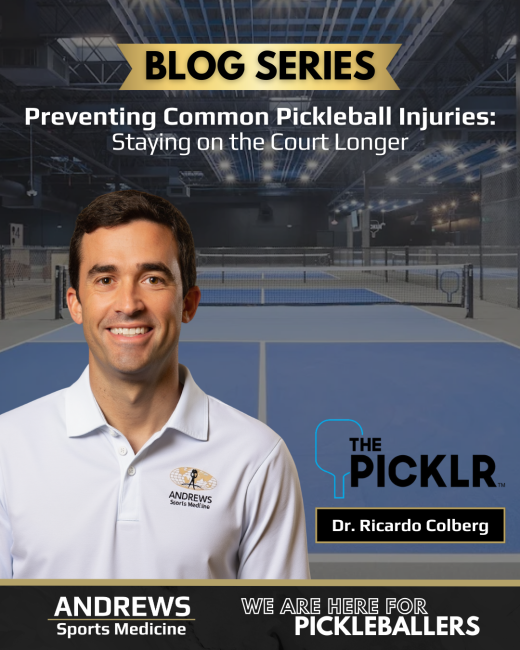
Preventing Common Pickleball Injuries: Staying on the Court Longer
By: Dr. Ricardo Colberg
Play Smarter, Play Longer
Whether you’re a competitive athlete or a passionate weekend player at The Picklr Birmingham, prioritizing injury prevention is the key to enjoying pickleball for years to come. By combining proper warmups, strength training, and smart recovery, players can protect their bodies — and keep their paddle in hand.
At Andrews Sports Medicine, our physicians are here to help pickleball athletes of all ages and skill levels stay at the top of their game.
The Most Common Pickleball Injuries
Like any fast-paced racquet sport, pickleball demands quick lateral movements, explosive changes of direction, and repetitive overhead motions. These movements often stress the joints, tendons, and ligaments.
“The most frequent injuries we see in pickleball include shoulder strains, pickleball elbow, knee pain, and ankle sprains,” explains Dr. Ricardo Colberg. “They may not sound severe at first, but if left untreated, they can develop into chronic issues that sideline players for weeks or even months.”
- Shoulder injuries often come from repetitive overhead smashes.
- Pickleball elbow is a form of tendinitis in the lateral elbow caused by repetitive paddle swings.
- Knee pain can stem from sudden pivots or squatting down in the kitchen to ??? balls.
- Ankle sprains occur with quick lateral movements, especially on hard court surfaces.
Injury Prevention: Building a Strong Foundation
Fortunately, most pickleball injuries are preventable with the right approach to warmup, conditioning, and recovery.
“Dynamic stretching before you play and strengthening your core and lower body can go a long way toward preventing injuries,” says Dr. Colberg. “We encourage athletes to think of themselves as training for a sport, not just showing up to play. That shift in mindset makes a big difference.”
Learn Proper Techniques
- Many injuries come from improper form
- Improper form can be overcome from taking lessons from a professional coach from facilities like The Picklr Birmingham.
Warm-Up Routine
- 5–10 minutes of light cardio (jump rope, jogging in place, or fast footwork drills)
- Dynamic stretches such as arm circles, leg swings, and torso rotations
Strength & Stability
- Squats, lunges, and resistance band work to strengthen the lower body
- Core stabilization exercises (planks, dead bugs) to support balance and agility
- Shoulder and forearm strengthening to protect against overuse injuries
Play Time
- If you are new to the sport, be mindful of your overall stamina.
- Many injuries occur when you are fatigued.
Smart Recovery: Keeping the Body Fresh
Injury prevention doesn’t end when you walk off the court. Recovery strategies are just as important, especially for players who train or compete multiple times a week.
“Ice, compression, and proper stretching after play can help reduce inflammation and soreness,” Dr. Colberg advises. “But equally important is listening to your body. If pain lingers more than a few days, it’s time to get evaluated. Ignoring it only prolongs recovery.”
Other recovery tools include foam rolling, soft tissue massage, and cross-training with low-impact cardio (such as cycling or swimming) to give the joints a break.
When to Seek Medical Attention
Many players wait until an injury becomes severe before seeking treatment. That delay can turn a minor tendon or joint issue into a more significant condition.
“If you experience pain that doesn’t improve with rest, or if it interferes with your daily activities, don’t ignore it,” says Dr. Colberg. “Sports medicine physicians can often treat these injuries non-surgically, helping you recover faster and safely return to play.”
CLICK HERE TO SUBMIT
AN APPOINTMENT REQUEST








